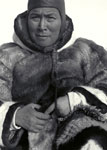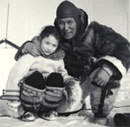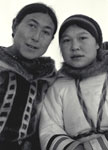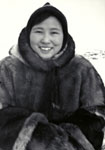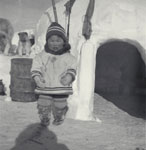|
|
||||||||
Peter PitseolakPeter Pitseolak (1902-1973) was an Inuit artist, historian, and pioneer photographer. He spent most of his life in traditional camps near Cape Dorset (Kingait) on the southwest coast of Baffin Island, in present-day Nunavut. During his lifetime, the North was experiencing immense social change - from nomadic living to permanent settlements, from close family structures to formal social registration, from kayaks and spears to skidoos and rifles. Concerned that much of the traditional knowledge - hunting techniques, stories, and myths - would be forgotten by his grandchildren's generation, Pitseolak used the camera to document a vanishing way of life. Taken by an Inuk, an insider, Pitseolak's photographs offer a unique way of seeing the Inuit. He photographed himself, his friends, and his family in real situations, thereby avoiding the stereotypes of the Inuit that some white people perceived. Sometimes he staged photographs of people wearing traditional clothing and using old hunting weapons as props. He photographed these in order to demonstrate, for future generations, how to perform traditional skills such as fishing or trapping. In 1912 Pitseolak met documentary filmmaker Robert Flaherty. Flaherty, a photographer who would go on to make the celebrated film "Nanook of the North" (1922), inspired Pitseolak's interest in photography. In 1923 Pitseolak married Annie from Kimmirut (formerly Lake Harbour). They had seven children, of whom only two daughters, Udluriak and Kooyoo, survived. Annie died of tuberculosis in 1939. In 1941, Pitseolak began living with Aggeok, who would be his companion throughout the next phase of his life—as a camp leader, photographer, artist, and historian. Pitseolak took candid photos of Aggeok in her traditional amauti, of his children, and of community members. With Aggeok he experimented with developing and printing photographs in their home. Working in a permanent structure would have been easier than their earlier efforts to develop photos in snow-houses during hunting trips, or in their quarmak (a large tent supported by wooden frames). However even in a wooden hut developing photographs posed challenges in that extreme climate changes and bright light levels from the reflective snow made this work difficult. It was also hard to obtain the film and chemicals needed. They nevertheless devised ingenious solutions to their technical problems: they made a lens filter from old sunglasses and developed prints with a flashlight covered by a piece of red cloth. Throughout the 1950's an increasing number of government administrators and technologies arrived in the North and transformed life: airplanes, helicopters, skidoos, diesel engines, electric generators, permanent housing, food stores, and Western clothing all left their mark. Traditional camps began to disappear as increasing numbers of Inuit were encouraged to move to permanent settlements established by the Canadian government. In 1961, at the age of 59, Pitseolak left his camp at Keatuk and returned to settlement life at Cape Dorset. Pitseolak was a historian of Inuit life from an Inuit perspective. He documented vanishing Inuit traditions through his images, oral histories, and record-keeping. He offered one of the few first-hand Inuit accounts of an era of immense cultural, social, and economic change. The photos presented here are merely a sample of Peter Pitseolak's vast collection. In his lifetime he took over 2,000 photographs. Through this work he was able to capture an intimate portrait of his community and his people - the people of Seekooseelak. Peter Pitseolak's family: Grandfather: Etidluie First wife: Annie- Annie was from Kimmirut (previously Lake Harbour) and married Peter in 1923. They had 7 children together, of whom just two daughters, Udluriak and Kooyoo, survived. Annie died from tuberculosis in 1939. Second wife: Aggeok - Pitseolak marries Aggeok (1906-1977) who participated in many of his photographic experiments. She became his principal developer and printer. Children: Udluriak (Manning), Kooyoo (Ottochie), Mary (a daughter with Nyla of Lake Harbour), Ashevak Ezekiel (step-son - Aggeok's son from a previous relationship). |
Bibliography · Links · Credits · Index

